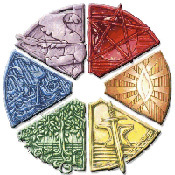We were chatting on the Discord a while back about discussing various sorts of magic from our favorite fantasy settings and media, to give people a better idea of how to use the flexible Open Legend mechanics in a way that still makes one’s own setting distinct and unique. When it comes to magic systems, in my opinion, the key is 100% in the way you self-limit and describe the effects you create. Giving a framework to newer players to help them build a character concept can be really freeing, as it gives them a way to start narrowing down the literally ENDLESS options given in Open Legend!
So I’m planning on posting a few Magic Systems in this thread, and would love to hear from other people in how they have flavored magic in their own campaigns!
I’m going to start with a system that is INCREDIBLY tedious, but I think translates simply and beautifully into Open Legend: The Pvaric Wheel of the Shek-Pvar in Columbia Games’ fantasy system, HarnMaster.
There was a lot of word salad in there so just real quick, some definitions of terms:
- Shek-Pvar–in Harnmaster, this is the catch-all term for the college of magic users. Magic is a subject of intense study and secrecy in Harn, and everything has its own fancy language surrounding it.
- Pvaric–relating to magic.
- Mavari–Apprentice. When a child or adolescent shows aptitude for magic, they are taken under the wing of an experienced magic user. That apprenticeship lasts for years, as the Mavari is educated in the principles of magic and the rules of their master’s specific order.
- Satia-Mavari–Journeyman. When a Mavari has completed their apprenticeship, They are released out to the world for a minimum of one year and one day. During that time they are not allowed to seek aid from any Shek Pvar college, as they rely on their own wits and magical knowledge to achieve mastery in their craft. Most adventurers are Satia-Mavari, and few ever make it past this rank. To promote, they must return after their journey and present to the college at least two spells they have invented on their own, and two items of “esoteric or magical value” to enhance the college for posterity.
- Shenava–Master. After completing their journey, magic users are promoted to this rank. Almost nobody progresses past this. Most magic users continue honing their particular school of magic, perfecting their own spells and keeping to themselves. An elite few continue their studies, learning the tenets of the other five schools of magic. If they master each of the schools, they can eventually become . . .
- Viran–Grand Master. These are also known as Grey Mages, masters not only of the various schools of magic, but also of magic itself. They have nearly godlike abilities, able to meddle in the natural order on unprecedented levels. There are rumored to be maybe six or seven Viran in the entirety of the world.
So, what are the various schools of magic one can learn?

This may just look like a fancy color wheel, but it actually represents the six “convocations,” or schools of magic. You might call them Elements, but they’re a little more complex than that. Each has its own fancy name, and attributes that go along with it.
Starting from Red, and working clockwise:
- Lyahvi–Element of the Air. Attributes: Sight, Scent, Sound, Intangibility. Often used for Illusion magic, though not its only application.
- Peleahn–Element of Fire. Attributes: Heat, Movement (particularly Acceleration), Activity. Shek-Pvar who specialize in this magic are often considered impulsive and destructive.
- Jmorvi–Element of Metal. Attributes: Form, Shape, Function, Craft. Often a slower and more deliberate magic, Jmorvi is known especially for the enchantment of items.
- Fyvria–Element of Earth. Attributes: Life, Death, Growth, Decay. These Shek-Pvar are often healers and botanists, focused on magic that other systems might consider Druidic, but can just as easily become cryptkeepers and necromancers.
- Odivshe–Element of Water. Attributes: Cold, Darkness, Quiescence, Vitiation. These Shek-Pvar are going to wield your darkness spells, your cone of colds, your slowed banes. However, their magics can be used in other, more creative ways as well. I once played an Odivshe Journeyman who wrote a spell that increased the slowing effects of alcohol on the drinker, effectively making the alcohol more potent.
- Savorya–Element of Spirit. Attributes: Thought, Emotion, Meaning, Will. Savorya is one of the more difficult convocations to wrap one’s head around. It is often used for Prescience-style abilities such as telepathy and Reading, and could at higher levels be used to charm or dominate or modify memory.
Writing spells in a particular convocation requires focusing on one of its primary attributes and building an effect around that particular attribute. If one wanted to use more than one attribute, or use it in a more complex/less obvious way, that would be a more difficult spell with a higher power level.
If a character wishes to branch out into other convocations once they’ve become a master, it is generally accepted that you begin with the “colors” closest to your own on the Pvaric wheel, as their principles are more closely aligned to yours. You eventually can branch out to the colors bordering THEM if you continue in mastery. The convocation directly opposite your own is the last you will learn, as its principles are diametrically opposed to the ones you first learned.
I am sure that your OL-loving minds are already coming up with a zillion different ways to interpret these principles and make them do wonderful and terrible things in your games ![]()
If you need an example though, here is a rough conversion of Manori, the Odivshe Shenava:
I hope this is helpful and interesting, and gives you some ideas for a magic system you may want to use!

